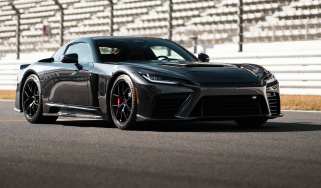The Ford Sierra RS500 Cosworth has been recreated in Group A touring car form
CNC Motorsport’s race-ready fast Ford is a perfect recreation of the Rouse-spec Group A touring car racers and will see action in historic series’

The first of CNC Motorsport’s three Ford Sierra RS500 continuations to be made has arrived with its owner. The car is built to the same specifications as the Andy Rouse Engineering Sierra RS500 Group A race cars, with a nod of approval for the continuation cars – attesting to their accuracy and quality – coming from Rouse himself.
That’s because CNC Motorsport is run by Alan Strachan, who worked alongside Rouse in period when running the Team Labatts Sierra RS500 – the very same featured in our Anatomy of a Ford Sierra RS500 feature in evo 325. Nevermind being one of the most recognisable Group A touring cars, the whale-tailed RS500 is an icon of motorsport as a whole and among the most beloved of all fast Fords.
The first continuation car took 24 months to assemble by Strachan and his son, with the team running the build alongside other projects including a Group A BMW 635CSI build, as well as an original Sierra RS500 restoration.
As for the final two cars of the three, the second is in build now using a brand new race-spec bodyshell, while a shell is in hand ready to start build of the third. A lot went into taking the Ford Sierra RS Cosworth from homologation special road car to fully paid-up race-ready weapon, which of course you can get the full lowdown on in our feature.
The car features a 575bhp Harvey Gibbs-built Cosworth YB engine, which sends power to the rear wheels via a period-correct Getrag five-speed transmission and 10-inch viscous differential. Apart from building the engine itself, CNC is handling the entire project, from fabrication and machining, cage to coils, to final assembly, it’s all Rouse, all CNC. The firm is the only certified by Motorsport UK to produce period-correct Andy Rouse Engineering cages.

The advantage of these continuation cars for prospective competitors in historic Group A series’ is that they are more affordable than an original car. Being built up from scratch by the team with the most experience of preparing the originals, they’ll be as faithful to the original specs as they are reliable. And being more affordable and without the historical baggage of period cars, the owners will hopefully field them more willingly, which is to the benefit of all who want to keep seeing the fire-spitting Sierras go wheel-to-wheel.
Alan Strachan, founder of CNC Motorsport, said: ‘These are to be enjoyed, raced hard and fair and without the concerns of taking a valuable, period car on track. The fans love to see these flame-spitting RS500s on the limit and they open the door to take part in a huge array of events across Europe.’







